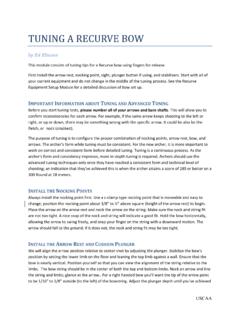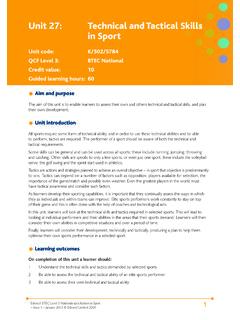Transcription of Best Practices TRAINING MANUNAL - TopScore
1 Best Practices TRAINING MANUNAL . [ v. ]. Confidence. Competition. Humility. TRAINING PILLAR STAFF: Chadrick Wigle (Section Leader), Yvonne Caples, Elizabeth Leddy, Richard Chen, Jeffery Mays GTF CONTRIBUTORS: Bill Billingham, Yvonne Caples, Richard Chen, Don DeVerges, Jack Joynt, Elizabeth Leddy, Stuart Lyon, Jeffrey Mays, Allen Nace, Jim Roach, Luke Runion, Henry Silva, Chadrick Wigle FACILITATED BY: Lynette Smith, USA Boxing Asst. Executive Director DJ Walton, USA Boxing Board of Directors INTRODUCTION. About the Grassroots Task Force Brought together in 2013 by the National office, the Grassroots Task Force is a working group of volunteers assembled by USA Boxing to provide performance and financial benefits to the 1,500. registered boxing clubs. Our sole purpose is to support our membership by providing valuable information that will enhance every aspect of running an amateur boxing program.
2 To learn more about the GTF or to volunteer, please contact: Preamble The TRAINING Pillar of the Grassroots Manual has been developed with the understanding that no empirical best exists when it comes to the sport of boxing. Efficacy is the only standard that matters and methods will vary from coach to coach and fighter to fighter. The primary purpose of the Grassroots TRAINING Pillar is to share successful boxing methodologies with new and seasoned coaches alike. This manual focuses on the standardization of fundamentals while allowing for individual coaches to develop their own unique competitive style. As the saying goes, Styles make fights. Styles vary because fighters and coaches vary. Each has their particular preferences and aversions. Every fighter possess his own specific set of strengths and weaknesses. Often, success is a matter of matching the athlete with the coach whose TRAINING method can best develop that athlete's innate abilities.
3 Ten different coaches can teach the jab ten different ways. If the jab is effective, then the instruction is valid. In our sport, words mean nothing without a person to bring them to life. Please feel free to adopt what you consider useful in any order you wish. The choice of how to proceed is completely yours. Manual topics include: Coaching, TRAINING , and teaching methodologies Techniques, tactics and strategies Athlete motivation Competition preparation Developing the team's support structure Summary of new rules (effective January 2014). The Art of Boxing as recreation for all ages and demographics detailed guides for skill analysis, day/week planning, and sparring sessions Advances techniques and tactics from around the world Page | 1. Grassroots Task Force | TRAINING Manual (2014). Suggested reading about coaching, strength and conditioning, nutrition, etc.
4 A TRIBUTE TO SARGE. The TRAINING Pillar of the Grassroots Manual is dedicated to the coaches who helped contribute to USA Boxing's success. It is our humble hope that our work helps in some small way to contribute to the continuance of the storied legacy of USA Boxing. Amateur boxing is advancing by returning the Practices that made boxing one of the biggest sports in the world. Scoring will be determined by the familiar 10. point must system and headgear will no longer be a requirement for experienced fighters. The last time Team USA fought for Gold without headgear was the 1976 Montreal Olympics where they earned 7 medals- 5 gold, 1 silver, and 1 bronze. We hope this change portends even greater success for Team USA as they again fight for Gold. This time in 2016 Olympics in Brazil. The United States amateur boxing community received a devastating blow on March 14, 1980 when 14 boxers, along with their coaches and administrative staff, perished in a plane crash on the outskirts of the Warsaw International Airport in Poland.
5 Lost among them was Coach Thomas Sarge Johnson (pictured with the 1976 Olympic team, front, middle right). Commenting on the loss, Sugar Ray Leonard said, He was one of the kindest, fairest men I've known. He was just beginning to get the recognition he deserved. He was really the one who put together those five gold medals.. While this manual is dedicated to all the coaches that have built USA Boxing, the Grassroots team would like to extend special recognition to Coach Sarge Johnson. May his shining example inspire you, the future makers of champions, to even greater success and glory for Team USA. Page | 2. Grassroots Task Force | TRAINING Manual (2014). TABLE OF CONTENTS. CHAPTER 1: COACHES. DEFINITIONS Page 09. The Coach The Second o Eligibility o Duties of the Second o Prohibited Activities USA BOXING COACH LEVELS & REQUIREMENTS Page 11. Coach Level 1.
6 Coach Level 2. Coach Level 3. SKILLS AND RESPONSIBILITIES Page 11. COACHING STYLES Page 12. Authoritarian Coaching (Autocratic Style). Co-operative Coaching (Democratic Style). Casual Coaching THE COACH INSIDE THE SPORT SYSTEM Page 12. Code of Conduct for Coaches The Sport System (flow chart). Positive Relations Inside the System PREVENTING COACH BURNOUT Page 15. Tips Prehab Exercises, Stretches, and more Develop a Personal Vision/Purpose Statement THE COACH-PARENT/VOLUNTEER RELATIONSHIP Page 18. Parent/Volunteer Education o General o Specific Parents/Volunteers as Valuable Assets SUGGESTED READINGS FOR COACHES Page 20. Page | 3. Grassroots Task Force | TRAINING Manual (2014). CHAPTER 2: TRAINING . TRAINING WITH BEGINNERS Page 22. TRAINING Stages GROUP COACHING Page 25. Teaching and TRAINING Methods ORGANIZING TRAINING SESSIONS Page 29. Facility Equipment Preparing TRAINING Programs BOXING TECHNIQUES Page 34.
7 Boxing Stance Boxing Steps Basic Punches Basic Defenses Combinations of Punches Feinting Boxing in Various Distances PHYSICAL TRAINING Page 65. Endurance Strength Speed Coordination ADVANCED TRAINING Page 67. Isometric TRAINING Plyometric TRAINING Over TRAINING TACTICAL TRAINING Page 69. Boxing against different character boxers change to different boxing types Boxing on the ropes and in the corner SPARRING Page 73. Safe Sparring Practices Types of Sparring Monitoring Sparring Sessions Appropriate Sparring Schedules TRAINING WITHOUT EQUIPMENT Page 77. Endurance TRAINING Strength TRAINING Speed TRAINING Coordination TRAINING Page | 4. Grassroots Task Force | TRAINING Manual (2014). ATHLETE MOTIVATION Page 77. RECOVERY Page 78. EVALUATION Page 79. TRAINING Sessions Technical Development Physical Development Tactical Development ADVANCED TECHNIQUES USA Page 81.
8 Boxing Stance Footwork Attacks Defenses TRAINING plan Development Past USA Boxing elite Super Stars SUMMARIES OF ADVANCED INTERNATIONAL STYLES Page 96. Cuba Russia Europe INDIVIDUALIZATION Page 97. Purpose of Individualization TRAINING Steps to Develop the Individualized TRAINING plan Individualization of Young Boxers Natural Characteristics and Growth of Boxers Experience Appropriate to the Development Analysis of performance Related to the Development Identification and Utilization of Methods for Development, TRAINING and Conditioning Analysis of the Boxer's Interest and Abilities to Box Control and Monitoring of TRAINING SUGGESTED READINGS FOR TRAINING Page 99. Page | 5. Grassroots Task Force | TRAINING Manual (2014). CHAPTER 3: COMPETITION. PRIOR TO THE COMPETITION Page 101. DURING THE COMPETITION Page 102. AFTER THE COMPETITION Page 105. RULES AND REGULATIONS (with USA Boxing Rules) Page 105.
9 Age Classification & Weight Categories (as per USA COMP rules). Eligibility of Boxers (as per USA COMP Rules). Duration and Number of Rounds (as per USA COMP Rules). Manual Scoring (as per USA TECH Rules). Fouls (as per USA Tech Rules). The Decision (as per USA TECH Rules). The Field of Play (FOP). Headgear Bandages/Hand Wraps SUGGESTED READINGS FOR COMPETITIONS Page 110. CHAPTER 4: ADDITIONAL ASPECTS IN BOXING. MEDICAL Page 112. Injuries Injury Prevention Treatment for minor injuries Treatment for severe injuries NUTRITION Page 115. WEIGHT MONITORING Page 116. BREATHING Page 117. SUGGESTED READINGS FOR ADDITIONAL ASPECTS Page 118. Page | 6. Grassroots Task Force | TRAINING Manual (2014). CHAPTER 5: THE ART OF BOXING. THE SPORT AND THE ART OF BOXING Page 120. DISTINCT POPULATIONS Page 120. Age Recreational Group Instructor Recreational Private Instructor Boxing TRAINING for Mixed Martial Arts CHAPTER 6: STEP-BY-STEP GUIDES.
10 TRAINING SUGGESTIONS BY AGE GROUP Page 123. HOW SAFE IS AMATEUR BOXING? Page 126. INGREDIENTS & RECIPES FOR Page 130. A Day plan Drill Design/Sparring Session EXAMPLE LESSON PLANS Page 131. Day plan Week MANAGING COMPETITION INJURIES FOR SECONDS Page 132. SKILL ANALYSIS FROM THE GROUND UP Page 133. Example Skill Checklists RESOURCES USED IN THIS MANUAL Page 141. APPENDIX. Appendix A: Strength & Coordination TRAINING Exercise Examples Page 144. Appendix B: Plyometric TRAINING Exercises Examples Page 149. Appendix C: Isometric TRAINING Exercises Examples Page 155. Appendix D: Physical Development Evaluation Examples Page 158. Appendix E: Coaching Tools (Blank Drill Sheets, Day plan , Week plan ) Page 166. Appendix F: Coach's Prehab Exercise Examples Page 169. Appendix G: Sample New Boxer Handouts Page 171. Appendix H: Medical Forms Page 180. Appendix I: Sample Drills from AIBA Peace & Sport Manual Page 185.





